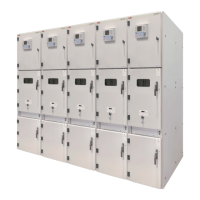11
—
4. Panel design and equipment
4.1 Basic structure and variants
The basis for the UniGear panel is the incoming /
outgoing feeder panel with vacuum or SF6 circuit-
breaker using insertion technology. It is divided
into busbar compartment, circuit-breaker
compartment, cable compartment and low
voltage compartment for the secondary
equipment. Apart from this, there are variants for
all operating needs.
For busbar sectionalising, two panels are
necessary, the coupling panel with the
withdrawable circuit-breaker part and a bus riser
panel (optional with busbar metering and
earthing). In equipment without busbar
sectionalising, a direct bar connection between
the busbars will be established.
UniGear switchgear also includes the variant of
incoming / outgoing panel with the switch-
disconnector. The panel is divided into busbar
compartment, switch-disconnector compartment
including cables and low voltage compartment
for the secondary equipment.
Further details about installation and switchgear
equipment can be obtained from the relevant
order documents.
4.2 Enclosure and partitioning
The enclosure and internal partitions of the
panels are of 2 mm thick high quality galvanized
steel sheets. The three medium voltage
compartments (busbar compartment, circuit-
breaker compartment and cable compartment)
are equipped with top-mounted and secured
pressure relief flaps. These open in the case of
overpressure due to an internal arc fault. The
front of the panel is closed off by pressure
resistant doors which open to an angle of 130°.
Cable and circuit-breaker compartments have
their own doors, both compartments can be
equipped with inspection windows made of
security glass. Neighbouring panels are
partitioned from one another by the side walls of
each panel and, as a result of the design, the air
cushion remains between these walls when the
panels are jointed together.
The enclosure is completed on the roof by top-
mounted pressure relief flaps which, according to
the rated current, are made of sheet steel or
expanded metal and at the base by means of
floor-covering made of Al sheet.
The pressure-relief flaps are secured with steel
screws on one longitudinal side and on the other
longitudinal side with plastic screws. In the case
of internal overpressure, the plastic screws are
the rupture point.
Arc fault current limitation can be achieved by
undelayed circuit-breaker release, carried out by
auxiliary switches operated by the pressure wave.
The switchgear can be equipped with Ith limiter:
the auxiliary switches are operated by the
pressure relief flaps.
The necessary safety measures to counteract the
effects of an internal arc fault must be ensured in
relation to the ceiling height. In individual cases,
this may require additional operator protection
measures on the switchgear panels. These
measures include:
1. Mounting a pressure relief duct on the top of
the switchgear, with further channels leading out
of the switchgear room in a form appropriate for
the design of the building. The shock wave and
arc discharge are channelled off in ducts.
2. Mounting a pressure relief duct with blow-out
apertures located above the duct at the ends of
the switchgear and pointing towards the centre
of the switchgear (diverter duct). The shock wave
and arc discharge then emerge in an extremely
attenuated form and in a location which is not
critical for the operating personnel.
The rear wall of the busbar compartment,
intermediate wall, mounting plate with shutters
and horizontal partition, form part of the internal
partitioning . The internal partitioning makes safe
access to the circuit-breaker and cable
compartments possible even when the busbars
are live.
The low voltage compartment for the secondary
equipment is completely protected from the
medium voltage area thanks to its steel-sheet
casing.
On the end sides, cover plates ensure a good
appearance and are mechanically and thermally
arc fault proof should such an event occur in the
end panel.

